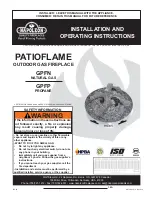
23
Fig. 40 Thermocouple Interrupter Block
Fig. 39 Microswitches
14.
SERVICING & PARTS REPLACEMENT
•
Always turn off the gas supply before commencing any servicing (The inlet elbow for this
appliance incorporates an isolating valve).
•
This product uses fuel effect pieces, burner compartment walls and gaskets containing
Refractory Ceramic Fibres (RCF), which are man-made vitreous silicate fibres.
Excessive exposure to these materials may cause temporary irritation to eyes, skin and
respiratory tract. Consequently, it makes sense to take care when handling these articles
to ensure that the release of dust is kept to a minimum. To ensure that the release of fibres
from these RCF articles is kept to a minimum, during installation and servicing we
recommend that you use a HEPA filtered vacuum to remove any dust and soot
accumulated in and around the fire before and after working on the fire. When replacing
these articles we recommend that the replaced items are not broken up, but are sealed
within a heavy duty polythene bag, clearly labelled as RCF waste. This is not classified
as “hazardous waste” and may be disposed of at a tipping site licensed for the disposal of
industrial waste. Protective clothing is not required when handling these articles, but we
recommend you follow the normal hygiene rules of not smoking, eating or drinking in
the work area and always wash your hands before eating or drinking.
•
Check that the appliance is clean and that soot or debris is not blocking the gaps
between the coals causing an imperfect flame.
•
Check that soot or debris is not impairing the electrode spark or pilot burner.
•
Check that soot or debris is not blocking any of the slots in the main burner.
•
After servicing, make sure that the ceramic walls and coals are replaced correctly as
described in the installation instructions.
•
Always test for gas soundness and spillage after servicing the appliance
.
14.1
TO REMOVE THE IGNITION MICROSWITCH (Figures 38 &
39)
The ignition microswitch is stamped V4NT9C4YC
14.1.1
Remove the bottom front cover.
14.1.2
Detach the microswitch cover by removing one screw and pulling clear of
the location lug (see figure 38).
14.1.3
Disconnect the leads from the ignition microswitch (The lower of the two
microswitches - See figure 39).
14.1.4
Detach the microswitch and insulation pad by removing two screws.
14.1.5
Replace in the reverse order. Check that the microswitch operates
correctly by fully closing it and observing that there are sparks at the pilot
electrode.
14.2
TO REMOVE THE GAS SHUT-OFF MICROSWITCH
(Figures 38, 39 & 40)
The gas shut-off microswitch is stamped V4NT9C2YCGPX or V4NT9C2YCAUX.
14.2.1
Remove the bottom front cover.
14.2.2
Detach the microswitch cover by removing one screw and pulling
clear of the location lug (see figure 38).
14.2.3
Loosen the thermocouple nut to free the microswitch leads and pull
the leads clear of the thermocouple interrupter block (see figure 40).
14.2.4
Detach the bridging bracket, microswitch assembly and insulation
pad by removing two screws (see figure 39).
14.2.5
Replace in the reverse order. When refitting the leads to the
interrupter block, make sure that they are secured firmly to give a good
electrical contact.
Fig. 38 Microswitch Cover Removal
Содержание Marseille BR622
Страница 9: ...9 Fig 6 Pack Contents...







































